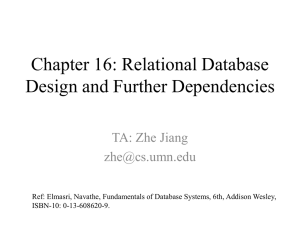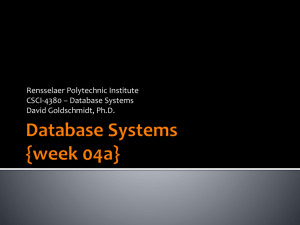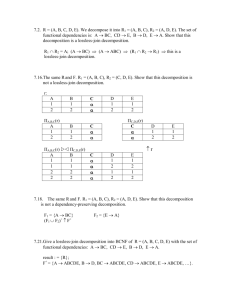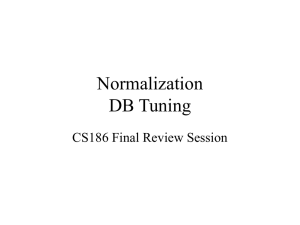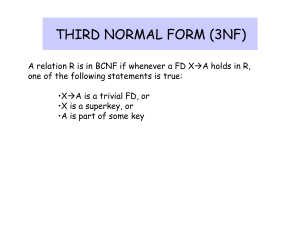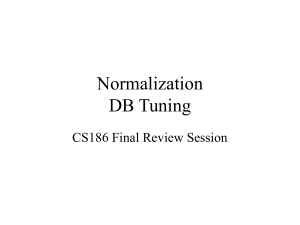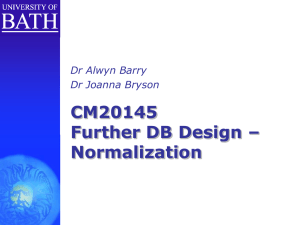Database Normalization Exercises & Solutions
advertisement
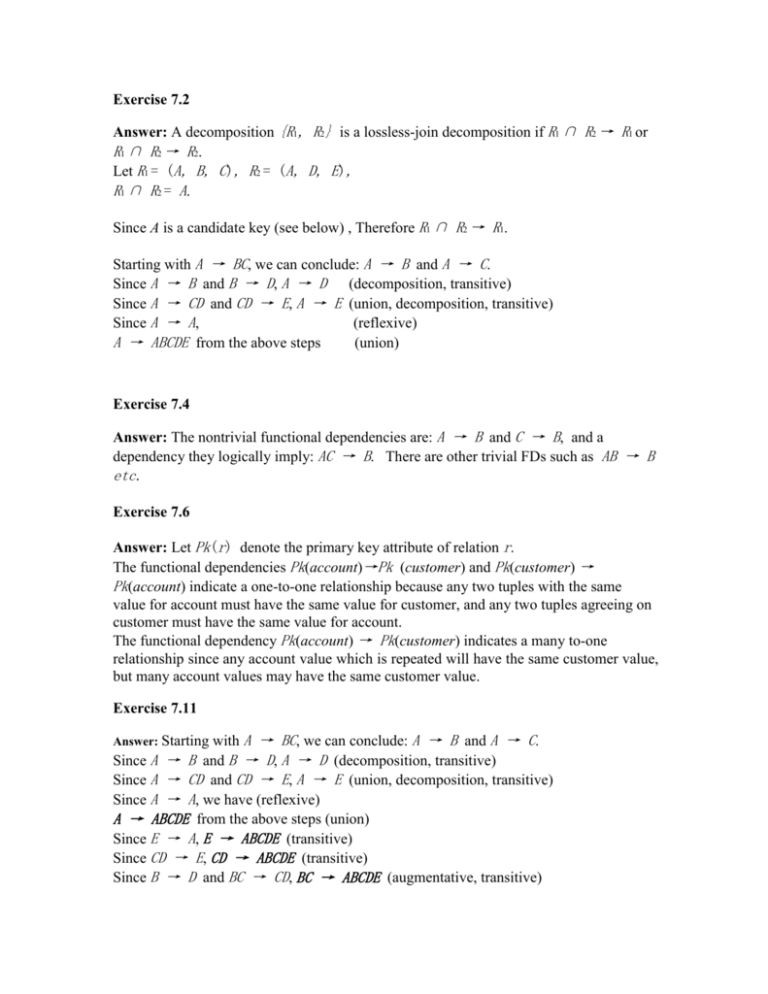
Exercise 7.2
Answer: A decomposition {R1, R2} is a lossless-join decomposition if R1 ∩ R2 → R1 or
R1 ∩ R2 → R2.
Let R1 = (A, B, C), R2 = (A, D, E),
R1 ∩ R2 = A.
Since A is a candidate key (see below) , Therefore R1 ∩ R2 → R1.
Starting with A → BC, we can conclude: A → B and A → C.
Since A → B and B → D, A → D (decomposition, transitive)
Since A → CD and CD → E, A → E (union, decomposition, transitive)
Since A → A,
(reflexive)
A → ABCDE from the above steps
(union)
Exercise 7.4
Answer: The nontrivial functional dependencies are: A → B and C → B, and a
dependency they logically imply: AC → B. There are other trivial FDs such as AB → B
etc.
Exercise 7.6
Answer: Let Pk(r) denote the primary key attribute of relation r.
The functional dependencies Pk(account)→Pk (customer) and Pk(customer) →
Pk(account) indicate a one-to-one relationship because any two tuples with the same
value for account must have the same value for customer, and any two tuples agreeing on
customer must have the same value for account.
The functional dependency Pk(account) → Pk(customer) indicates a many to-one
relationship since any account value which is repeated will have the same customer value,
but many account values may have the same customer value.
Exercise 7.11
A → BC, we can conclude: A → B and A → C.
Since A → B and B → D, A → D (decomposition, transitive)
Since A → CD and CD → E, A → E (union, decomposition, transitive)
Since A → A, we have (reflexive)
A → ABCDE from the above steps (union)
Since E → A, E → ABCDE (transitive)
Since CD → E, CD → ABCDE (transitive)
Since B → D and BC → CD, BC → ABCDE (augmentative, transitive)
Answer: Starting with
Also, C → C, D → D, BD → D, etc.
The candidate keys are therefore A, BC, CD, and E.
Therefore, any functional dependency with A, E, BC, or CD on the left hand side of the
arrow is in F+, no matter which other attributes appear in the FD.
Allow * to represent any set of attributes in R, then F+ is BD → B, BD → D, C → C,
D → D, BD → BD, B → D, B → B, B → BD, and all FDs of the form A∗ → α,
BC ∗ → α, CD∗ → α, E∗ → α where α is any subset of {A, B, C, D, E}.
Exercise 7.12
Answer: Computing B+ by the algorithm in Figure 7.7 we start with result = {B}.
Considering FDs of the form β → γ in F, we find that the only dependencies
satisfying β ⊆ result are B → B and B → D. Therefore result = {B, D}. No
more dependencies in F apply now. Therefore B+ = {B, D}
Are there any inferred functional dependencies in the functional dependencies in
the set of FDs for exercise 7.11?
Answer: There is some misunderstanding here.
We have some functional dependencies that are inferred. For example, A → B and A →
C are inferred from the given A → BC.
Some student answer NO since in 7.11 we finish with the closure of F which by
definition includes all functional dependencies. There would be no more inferred FDs .
I took both answers as correct as long as you explain your answer. Please do not use one
simple word “YES” or “NO” for your answer.
Show that the following decomposition of the schema in Exercise 7.2 is not a
lossless-join decomposition: (A, B, C) and (C, D, E).
Answer: You can use a counter-example to show it is not a lossless-join decomposition.
Or you use the condition as in 7.2
A decomposition {R1, R2} is a lossless-join decomposition if R1 ∩ R2 → R1 or R1 ∩ R2 → R2.
Let R1 = (A, B, C), R2 = (C, D, E),
R1 ∩ R2 = C.
However, C+ = {C} thus Neither C → R1 Nor C→ R2 holds.
Give a lossless join decomposition into BCNF of schema R of Exercise 7.2.
Answer : From Exercise 7.11, we know that B → D is nontrivial and the left hand side is
not a superkey. By the algorithm of Figure 7.13 we derive the relations {(A, B, C, E),
(B, D)}. This is in BCNF.
You may have other decompositions as long as it is in BCNF.
Give a lossless-join, dependency-preserving decomposition into 3NF of schema R
of Exercise 7.2.
Answer : The original schema R = (A, B, C, D, E) is already in 3NF.
You may also create a schema from the algorithm of Figure 7.14
R = {(A,B,C), (C,D,E), (B,D), (E,A)}.
Schema (A, B, C) contains a candidate key. Therefore R is a 3NF dependencypreserving lossless-join decomposition.
You may have other decompositions as long as it is in 3NF.
For each of the following relation schemas and sets of FD’s:
o R is (A, B, C, D) with FD’s A -> B, B -> C, C -> D, D -> A.
o R is (A, B, C, D) with FD’s B -> C and B -> D.
Identify candidate keys for R
Indicate BCNF violations and decompose if necessary.
Indicate 3NF violations and decompose if necessary.
Answer:
1. A->ABCD, B->ABCD, C->ABCD, D->ABCD
Thus, candidate keys are A,B,C,D
Since all are candidate keys, there is NO BCNF Nor 3NF violations. No
decomposition necessary.
2.
AB->ABCD.
Thus, AB is candidate key.
B->C, B-D both violate BCNF
– Since the closure of B (B+) does NOT include all R’s attributes.
– B+ = {B,C,D}
One possible BCNF decomposition is {(A,B),(B,C,D)}
B->C, B-D both violate 3NF
B is not a superkey, and C,D are not part of a candidate key
One possible 3NF decomposition is {(A,B),(B,C,D)} or {(A,B),(B,C) (B,D)}
